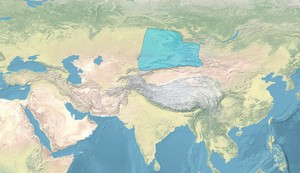
Back Cuatro Oirates AST Oyrat xanlığı Azerbaijani Dörben Oirat German Cuatro Oirates Spanish Quatre oïrats French ドルベン Japanese ოირათთა სახანო Georgian 오이라트 4부족 연맹 Korean Ойрот биримдиги (15-кылымдын башы) Kirghiz Дөрвөн Ойрадын холбоо Mongolian
Alliance of the Four Oirats ᠳᠥᠷᠪᠡᠨ ᠣᠶᠢᠷᠠᠳ Дөрвөн Ойрад Dorben Oirad | |||||||||||||
|---|---|---|---|---|---|---|---|---|---|---|---|---|---|
| 1399–1634 | |||||||||||||
The Oirat Confederation and contemporary Asian polities c. 1600 | |||||||||||||
| Status | Confederation | ||||||||||||
| Common languages | Mongolic | ||||||||||||
| Religion |
| ||||||||||||
| Government | Monarchy | ||||||||||||
| Taishi | |||||||||||||
| Legislature |
| ||||||||||||
| Historical era | Postclassical to early modern period | ||||||||||||
• Möngke-Temür places himself at the head of the Oirats | 1399 | ||||||||||||
• Oirats overthrow a Genghisid Khagan | 1399 | ||||||||||||
• Esen Taishi becomes Northern Yuan Khagan | 1453-54 | ||||||||||||
• Movement of the Torghuds to the Volga | 1616–17 | ||||||||||||
• Establishments of the Dzungar Khanate and the Khoshut Khanate | 1630s | ||||||||||||
• Disestablished | 1634 | ||||||||||||
| |||||||||||||
The Four Oirat (Mongolian: Дөрвөн Ойрад, Dorben Oirad; Chinese: 四衛拉特); also Oirads and formerly Eleuths, alternatively known as the Alliance of the Four Oirat Tribes or the Oirat Confederation, was the confederation of the Oirat tribes which marked the rise of the Western Mongols in the history of the Mongolian Plateau.
Despite the universal currency of the term "Four Oirat" among Eastern Mongols, Oirats, and numerous explanations by historians, no consensus has been reached on the identity of the original four tribes. While it is believed that the term Four Oirats refers to the Choros, Torghut, Dorbet and Khoid tribes,[2] there is a theory that the Oirats were not consanguineous units, but political-ethnic units composed of many patrilineages.[3] In the early period, the Kergüd tribe also belonged to the confederation.[4]
- ^ William Elliott Butler-The Mongolian legal system, p.3
- ^ René Grousset Empire of Steppes, p.341
- ^ C. P. Atwood Enc, p.310
- ^ Ssetsen (Chungtaidschi.), Ssanang (1829). Geschichte der Ost-Mongolen und ihres Fürstenhauses: Aus dem Mongolischen übersetzt, und mit dem Originaltexte (in German). Europe Printing.

